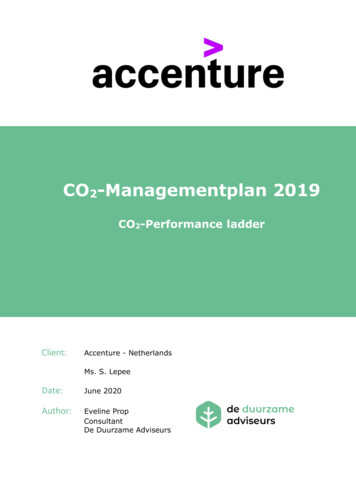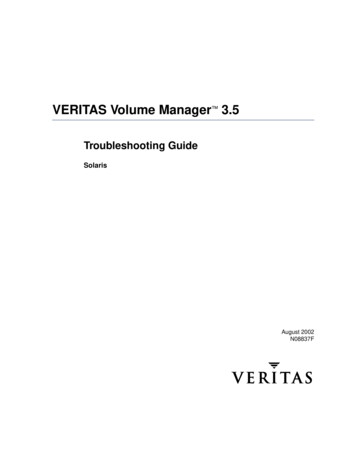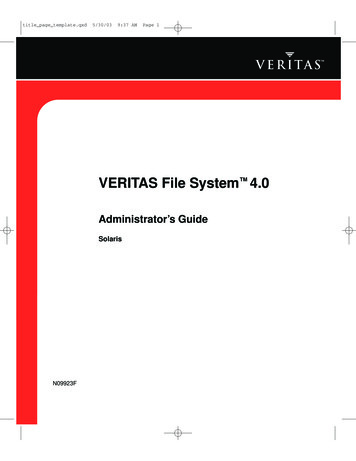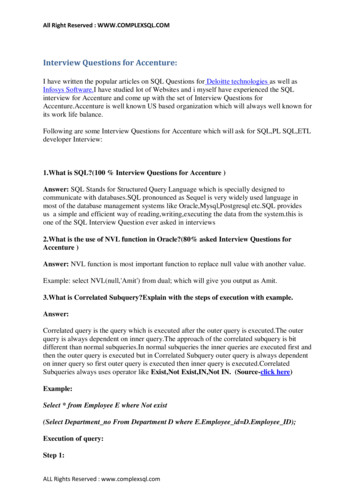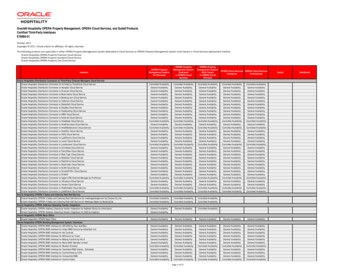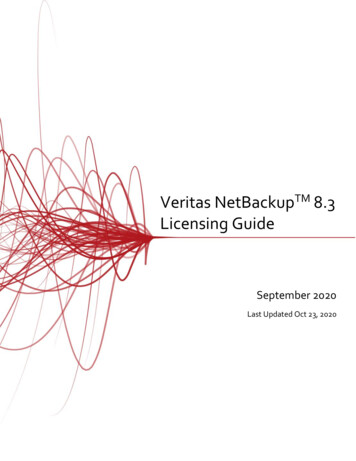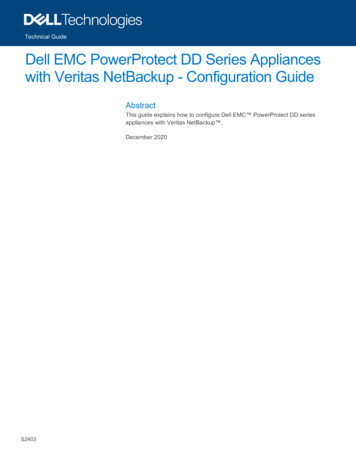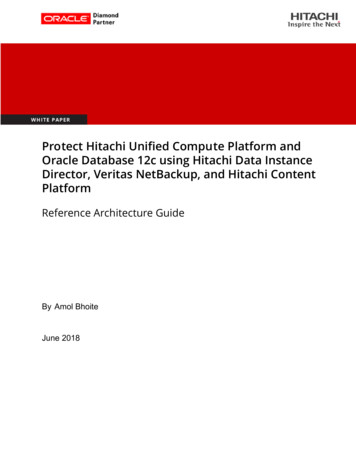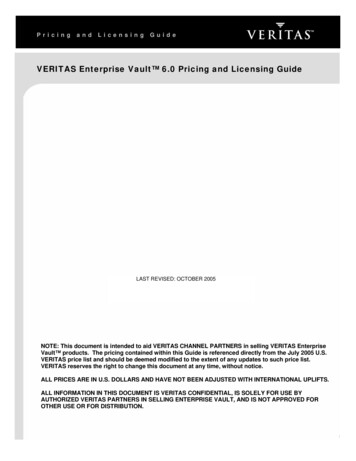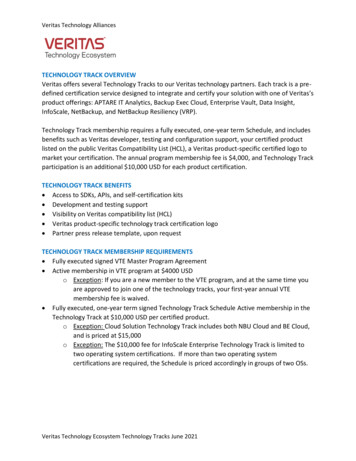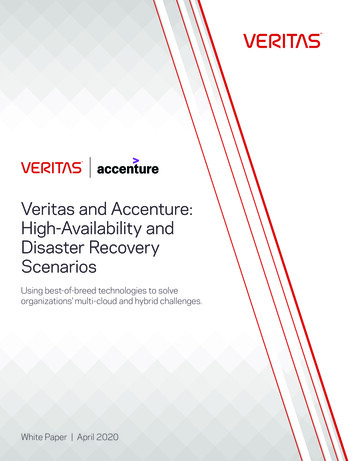
Transcription
Veritas and Accenture:High-Availability andDisaster RecoveryScenariosUsing best-of-breed technologies to solveorganizations’ multi-cloud and hybrid challenges.White Paper April 2020
ContentsIntroduction . . . . .3Scenario 1: Ensure Multi-Cloud DR with InfoScale . . .3Context and Client Challenges . . 3Our Approach . . . .4Conclusion . . . .7Scenario 2: Build Hybrid-Cloud DR with Resiliency Platform . . 7. . 7. .Context and Client Challenges .Our Approach . . . .Conclusion . . . 11. .82
INTRODUCTIONA hybrid cloud approach enables an organization to combine best-of-breed technologies while increasing cost-effectiveness andensuring independence from a single hosting provider. There are many reasons why organizations are moving to the cloud, such as to: Become more agile and flexible. Innovate faster. Shift everything to the “as-a service” model. Simplify IT operations. Improve application high availability (HA). Enable low-cost disaster recovery (DR).Thinking about an HA/DR strategy, implementing it and confirming it works is crucial to ensuring an organization’s business continuity isimpacted by minimal application downtime. In this context, it’s essential to understand the ecosystem of the organization’s applicationsand their dependencies.Typically, there are two business scenarios we encounter: Multi-Cloud—Organizations that are migrating their entire application services portfolio to the cloud or have adopted an all-in or“full-cloud” strategy with their cloud providers and need better application HA performance and resiliency. Hybrid—Organizations that prefer to adopt a hybrid model where application services are hosted on-premises and in the cloud orbetween clouds.Veritas and the Accenture Cloud Innovation Center (ACIC) have worked synergistically to develop established blueprints to addressthese scenarios to support organizations during their journey to the cloud: Multi-Cloud—Using Veritas InfoScale , we help organizations design an application-aware solution for HA and DR in afull-cloud context. Hybrid—Using Veritas Resiliency Platform, we help organizations during their migration to the cloud, managing hybrid DRarchitectures able to run nondisruptive tests and Instant Recovery Restores in a single pane of glass.SCENARIO 1: ENSURING MULTI-CLOUD DR WITH INFOSCALEContext and Client ChallengesHybrid clouds are becoming standard for many enterprises. The factorsCloudAvailabilityZone 1driving this decision include increased flexibility as well as savings inCloudAvailabilityZone 2capital expenses (CapEx) and operating expenses (OpEx). Although thereis considerable interest in hybrid-cloud deployment models, ensuringseamless data movement, enterprise performance, scalability andresilience can be challenging. An unplanned disruption to the business/data center can have highly destructive and far-reaching impacts onCloudAvailabilityZone 3productivity, customer services, the supply chain and revenues. To avoidthis outcome, enterprises must implement robust solutions to ensuretheir services are always up and running.Figure 1. Enable application high availability (HA)by using multiple AWS availability zones.When it comes to the cloud, and specifically to Amazon Web Services (AWS), intelligently using availability zones and geographicalareas can make the difference in business continuity. Such a strategy protects organizations against the failure of a single availabilityzone and/or geographical area, keeping the service always on. (See Figure 1.)3
In this context, InfoScale enables organizations to protect their most important applications from planned and unplanned downtimewhile providing HA and DR solutions for critical business services, including individual databases, custom applications and complex,multi-tiered applications across virtual and physical environments over any distance.InfoScale monitors applications and infrastructure to detect possible risks to availability and automatically recovers applications whenneeded. InfoScale also detects site outages and initiates application recovery at a DR site. With built-in testing to proactively detectand report potential problems before they can impact IT services, InfoScale helps minimize unwanted downtime of critical businessservices.Our ApproachTo address the need for a service to be always up and running, Accenture and Veritas chose Veritas InfoScale technology. As softwaredefined storage solution, InfoScale offers enterprise-grade capabilities for organizations looking to deploy and run top-tier applicationsacross multiple clouds. InfoScale delivers a complete suite of capabilities for organizations looking to deploy a robust, multi-cloudinfrastructure that includes public clouds such as AWS, Microsoft Azure and Google Cloud. InfoScale does so by offering: Intelligent data movement to the cloud—Organizations need to ensure they’re moving data to the cloud in an optimal way.InfoScale includes SmartMove technology that ensures efficient, intelligent data migration to help organizations save on bandwidthand storage costs while migrating application data to the cloud. SmartMove analyses storage usage by looking up the file system(VxFS) metadata and moving only relevant or active data to the cloud. For example, if an organization has provisioned 10 TBof storage and has 3 TB of active (non-deleted) data, then a standard data mover typically moves 10 TB of data to the cloud byconsidering all non-zero-bit strings as valid data. In contrast, InfoScale’s SmartMove technology looks up the file system metadataand then moves only the non-deleted or active data to the cloud. SmartMove can also optimize data movement to the cloud in termsof CPU, bandwidth and schedule. Applications failure management in seconds—Many, if not most applications require HA in the event of a node (compute and/or data), availability zone or regional outage. InfoScale provides automated remediation actions via its Intelligent MonitoringFramework (IMF), which monitors applications at a service level and triggers a failover in seconds, not minutes, when it detects anapplication failure. Organizations can even perform a “fire drill” to identify potential problems and ensure applications will failoverpredictably. InfoScale offers application-aware agents for leading enterprise applications, and organizations can write customagents for in-house applications. Volume and file-level replication ensure application data is replicated to other AWS availabilityzones or regions to protect against a large-scale infrastructure outage. Software-defined storage capabilities—Today’s data centers have multiple layers of physical and virtual environments, each withits own administrative tools, with applications or entire business services composed of multiple components that interact with eachother despite running on different operating systems and virtualization technologies. InfoScale provides automated, orchestratedrecovery of applications composed of multiple components running on different virtual tiers (see Figure 2).Figure 2. Monitoring Apache application components via InfoScale.4
With InfoScale, IT administrators can not only recover failed applications but also automatically orchestrate the connection to othercomputing resources needed to keep the business service available via a faster recovery with minimal downtime and no manualintervention. (See Figure 3.)Figure 3. Admins can use InfoScale’s central dashboard, Operations Manager, to manage data and application failures. Compatibility with hundreds of applications and databases—InfoScale provides off-the-shelf support for a wide range ofapplications, reducing deployment times for SAP , BEA , Siebel , Oracle applications, Microsoft Exchange and PeopleSoft as wellas enterprise-class databases such as Oracle, DB2, Microsoft SQL Server and Sybase. Storage reliability and performance—Mission-critical applications demand the same performance and resiliency characteristicsas they do on-premises. The SmartIO and Flexible Storage Sharing (FSS) technologies in InfoScale provide performance gains andshared storage capabilities that deliver predictable service-level agreements (SLAs).ν SmartIO—In AWS, SmartIO uses instance store-SSD storage closest to compute as a data caching device to improveperformance. The result: InfoScale’s SmartIO technology accelerates the workload’s throughput by 4X (for a 20 percentcache hit).ν Flexible Storage Sharing—FSS in AWS uses elastic block storage (EBS) volumes and creates a shared-nothing cluster to meetprotocol flexibility and performance needs and delivers horizontal scalability for enterprise applications. The result: InfoScale’sFSS technology allows organizations to scale IOPS linearly. Organizations can even run multiple applications in a single FSScluster and set up SLAs to ensure isolation among applications. This type of deployment unlocks valuable use cases such asrunning real-time analytics on incoming transactional data or fraud detection on credit card transactions. Broad hardware and platform support—InfoScaleis the only solution that supports all leadingoperating systems, including Windows, Linux andvirtual platforms including VMware ESX , RedHat Enterprise Virtualization (RHEV), Oracle VMand Hyper-V. As proved in the ACIC Lab, InfoScalealso ensures application availability in full-cloudenvironments hosted in AWS, Azure and Google. Simplified migration and integration—InfoScalemonitors applications and, in case of failure,handles their recovery to a healthy virtual machine(VM) running on a different platform. InfoScale alsoenables organizations to easily migrate workloads,automatically supporting physical, virtual and allmajor public clouds, thus avoiding vendor lock-in.(See Figure 4.)Figure 4. Monitoring application movement via InfoScale’scentral dashboard, Operations Manager.5
In this specific ACIC scenario, we focused on an AWS full-cloudenvironment with application HA guaranteed by InfoScale and appliedto multiple availability zones (see Figure 5).Deployment of the InfoScale environment on AWS is based on theAWSAmazonAvailabilityZone 1AWSfollowing best practices: Using AWS Cloud Formation to create cloud-based InfoScaleenvironments to accelerate deployment (see Figure 6). Developing applications on AWS Elastic Compute Cloud (EC2)instances, not relational database service (RDS) instances. Using AWS Elastic Block Storage (EBS) to enable data mirroringbetween availability zones and data replication betweengeographical areas.InfoScaleAWSAmazonAvailabilityZone 2AmazonAvailabilityZone 3Figure 5. InfoScale enables application HAin a multi-availability zone scenario. Using AWS Elastic Load Balancer (ELB) to manage traffic routingbetween availability zones. Applying the required routing tables to allow application services to properly communicate between availability zones. Using a Coordination Point Server on a third availability zone (optional and not included in this scenario) to arbitrate in case ofnetwork failures between availability zones.Following these guidelines and using InfoScale, we’ve enabled a high-performance, Apache-based application to be highly available,thus guarantying service continuity between different AWS availability zones in two main situations: Application downtime. AWS availability zone downtime.Figure 6. AWS Cloud Formation deployment of InfoScale environments.6
AWS ElasticLoad BalancerVIOMApplication HAEC2 InstanceEBS MagneticHDD and SSDEC2 InstanceEBS MagneticHDD and SSDAvailability Zone 1Availability Zone 2Figure 7. A high-level design of how InfoScale enables application HA/migration between AWS availability zones.This scenario includes use of additional AWS features such as ELB to enable service continuity transparently (see Figure 7).ConclusionOrganizations need to use new, innovative solutions and technologies to enable high-performance applications to become highlyavailable and guarantee minimum business downtime. Accenture and Veritas are excited to fill that need by using InfoScale to providethe following advantages: Intelligent data movement to the cloud. HA between AWS availability zones and DR between different geographical areas. Storage reliability and performance. Application services that are always up and running by managing failures transparently to the application service. Software-defined storage capabilities. A simple approach for all the business-critical applications that supports a broad range of architectures: physical to virtual, virtualto virtual, physical/virtual to cloud, cloud to cloud and cloud to physical/virtual. Integration with Veritas Resiliency Platform to provide a single pane of glass for orchestrating any kind of architecture.SCENARIO 2: BUILDING HYBRID-CLOUD DR WITH RESILIENCY PLATFORMContext and Client ChallengesBusiness continuity orchestration is an essential part of any organization’s planning and operation, and many are increasingly facedwith the need to reduce infrastructure and management costs while deploying high-performance resilient architectures. This mandatetranslates into increased time and complexity required for proper DR management.The cloud has been the next big thing in IT since virtualization, andorganizations around the world are adopting it. Although the cloud offersbig benefits with the potential for high business returns in the short term,ResiliencyPlatformorganizations need to stay agile and view the cloud as just one strategicelement of an independent business strategy that protects businessapplications around-the-clock and ensures a strong return on (ROI), regardless of where applications are hosted. The key is fororganizations to be able to move business services on demand seamlesslyto and from any single cloud or even across multiple, disparate cloudsas needed. Such organizations need help managing and orchestratingthe business continuity of their services as well as managing migrationsfrom on-premises to the cloud and/or between clouds without losing thebenefits of a hybrid-cloud strategy. (See Figure 8.)On-Premises InfrastructurePublic Cloud ProviderFigure 8. Enable easy management of a hybrid-cloud environmentvia a single pane of glass with Resiliency Platform.7
Whether you’re adopting the cloud as a permanent location for business applications or as a temporary home for applications in case ofa DR scenario, there are several factors to consider before making the move. Cloud migration—Migrating business workloads to the cloud can be tricky and complex due to multiple moving parts. Organizationsneed to secure business data during the transfer from on-premises to the cloud and consider the dependencies within complex,multitier applications. Another potential roadblock is not having the ability to test migrations or to test how workloads performin the cloud before moving services off-premises. Without advance testing, organizations can incur thousands or even millions ofdollars in lost revenue if a migration doesn’t go smoothly or if applications don’t work as expected in the cloud. The biggest risk,however, arises when an organization hasn’t carefully thought out its long-term cloud strategy. Today, the move to the cloud maybe economical, but in a few years, an organization may want to move applications back on-premises or to another cloud if businesspriorities change. Without a failsafe for doing so, they may end up harming their long-term ROI. Cloud disaster recovery—DR is essential, and whether organizations are adopting a cloud-based DR approach for all businessoperations or just some of them, the potential CapEx savings can be tremendous. It’s essential to ensure that OpEx doesn’tsuddenly skyrocket, however, organizations commonly employ application or workload resiliency measures to maintain businessand application continuity. They could be managing resiliency operations across a hybrid-cloud architecture where resiliencypersonnel are managing legacy applications in on-premises data centers as well as managing resiliency across new cloudarchitectures, which requires additional training. Using multiple tools across different sub-environments can also lead tofragmentation, causing visibility and subsequent management issues and leading to an increased risk of downtime. Another keyaspect many organizations fail to consider is whether they have a reliable way to test their DR strategy. Unfortunately, some stillrely on an inefficient, all-hands-on-deck manual approach and weekend testing, which can be costly and time-consuming.Our ApproachDespite today’s often-complex application infrastructures, it’s possible to ensure predictable resiliency for your business applicationsacross hybrid and multi-cloud architectures. To do so, your business likely requires: A unified, automated approach that considers resiliency for applications across all locations, including the cloud. The ability to proactively test and re-test your migration strategy and DR preparedness easily whenever required without disruptingnormal business operations. The flexibility to move your business applications to any target location, including the ability to migrate or failback applications fromthe cloud to on-premises at a moment’s notice.Organizations can finally address all these requirements with Veritas Resiliency Platform. (See Figure 9.)Veritas IMSvCenterAppAppAppDataDataDataVeritas DMResiliencyPlatformVeritas DMVeritas IMSCloud-OptimizedSecure EC2InstancePrimary SiteSecondary SiteFigure 9. A high-level design of how to manage application DR/migration in AWS with Resiliency Platform.8
Furthermore, integrating an organization’s hybrid environment with Veritas NetBackup ensures a smoother recovery for all those VMsthat don’t need a short recovery point objective (RPO). The result is a ready-to-use environment with no waiting for restore time.The key components of Resiliency Platform deployed in this scenario are: Resiliency Manager—Deployed as a virtual appliance hosted in the AWS cloud, Resiliency Manager is responsible for data centerdiscovery, providing information on the assets to protect (storage arrays, VMs, applications) within a resiliency domain (theorganization’s infrastructure). Infrastructure Management Server—Deployed as virtual appliances hosted in the AWS cloud, Infrastructure Management Serversare exploited by the Resiliency Manager to discover and monitor assets (storage arrays, VMs, applications) within a data center toenable proper management and protection of the organization’s infrastructure. Data Mover—Deployed as a virtual appliance hosted in the AWS cloud, the Data Mover is responsible for replicating VM data andconfiguration from the local (source) data center to the remote (target) data center. This capability addresses migration to the cloudas well as hybrid or full-cloud DR, including nondisruptive DR testing.Using Resiliency Platform enables organizations to: Orchestrate complex recoveries with predictability—Organizations typically have large groups of applications and/or VMs, someor all with complex interdependencies that must be considered during stop and start procedures. When large-scale failures orsite outages occur, organizations don’t have time to waste on manual procedures. Their DR procedures must be executed quicklyand flawlessly regardless of any underlying complexities. Ensuring success requires taking minimal steps along with providinga dashboard view to ensure visibility into when services come back online and identify any problems. Resiliency Platform fullyautomates all recovery procedures across a multi-vendor, multi-platform environment so admins can easily perform site-to-sitelarge-scale recoveries with just a single click. A central dashboard provides visibility into how applications are meeting definedservice-level objectives (SLOs) along with end-to-end visibility into recovery procedures to help monitor progress and resolveproblems quickly, if required. (See Figure 10.)Figure 10. Easily manage a DR event via Resiliency Platform’s central dashboard.9
Figure 11. Execute a DR preparedness test with no impact to already-running applications with Resiliency Platform. Ensure DR readiness with nondisruptive testing—Organizations shouldn’t wait for a disaster to find out if their recovery plan willsucceed. DR testing is vital, but is too often labor-intensive and carried out only during weekend hours. Businesses need to provideproof or assure internal and external stakeholders they will recover if a disaster is declared. They need the ability to test at anytime without disrupting normal business operations and without requiring all-hands-on-deck during weekend hours. With ResiliencyPlatform and NetBackup, organizations can now nondisruptively rehearse recovery plans at any time to ensure proactive DRreadiness and predictable recovery. Veritas provides a unified approach to testing that considers the need for business applicationsto recover data from disparate sources such as NetBackup or via hardware-based or host-based replication. The Veritas unifiedresiliency solution provides up-to-a-millisecond view of the time required for a business to recover services, performs automatedclean-up to quickly release resources without manual involvement and enables organizations to prove compliance with internal andexternal business continuity mandates. (See Figure 11.) Achieve any SLO—An organization’s business applications likely span a range of SLOs. Backup and replication technologiesare designed for different service levels and are usually managed separately with different processes and teams. Centrallymanaging resiliency for all SLOs requires centralized visibility and control of data availability across both backup and replicateddata transports. Resiliency Platform’s direct integration with NetBackup delivers resiliency for any SLO—from the top tier to thebottom—with simple management from a single console. This approach reduces manual efforts and OpEx, letting backup andvirtualization admins concentrate on more important tasks. And most important, it helps avoid the chaos many organizations facewithout this level of unified resiliency. Seamlessly migrate complex,tiered applications betweenon-premises and the cloud—Business applications shouldn’t betied to a single location. Instead,organizations should be able tomove applications and data easilyanywhere, depending on businessand budgetary needs, whether it’sto the cloud or back on-premises(see Figure 12).Figure 12. Enable easy workload migration in a hybrid-cloud scenario with Resiliency Platform.10
Resiliency Platform enables seamless movement of even the most complex workloads between on-premises and the cloud with asingle click as well as quick migration of workloads including I/O-intensive applications to the cloud. Plus, businesses can stay agileand flexible with the option to failback services to on-premises, as needed. Extend on-premises resiliency to the cloud with a unified hybrid-cloud strategy—Don’t let an on-premises workload andapplication resiliency strategy keep your organization from moving to the cloud. Instead, confidently expand from on-premisesto multi-cloud architectures with a resiliency plan that scales easily and cost-effectively as the organization innovates while alsoensuring application environments don’t become fragmented. With Resiliency Platform, organizations can easily adopt the cloudwith a resiliency strategy that cost-effectively scales from on-premises to the cloud and eliminates the need for multiple point toolsacross different parts of the environment. Choosing a single resiliency solution that spans on-premises, legacy environments andthe cloud saves on OpEx, avoids environment fragmentation, increases visibility and minimizes the risk of downtime. This approachdelivers real-time and historical SLO monitoring and reporting across an entire hybrid environment along with single-pane-of-glassvisibility, so admins stay informed about the organization’s IT health. Plus, IT only needs to be trained on one, easy-to-use, unifiedresiliency platform interface.ConclusionWith the widescale adoption of hybrid-cloud environments, organizations are asking for a unified solution that help proactively maintainbusiness uptime and migrate workloads across private, public and hybrid clouds. Accenture and Veritas can answer these needs withResiliency Platform by providing a solution to: Orchestrate complex recoveries with predictability. Ensure DR readiness with nondisruptive testing. Achieve any SLO. Seamlessly migrate complex, tiered applications between on-premises and the cloud. Extend on-premises resiliency to the cloud with a unified hybrid-cloud strategy.ABOUT ACCENTUREAccenture is a leading global professional services company, providing a broad range of services in strategy and consulting, interactive,technology and operations, with digital capabilities across all of these services. We combine unmatched experience and specialized capabilitiesacross more than 40 industries—powered by the world’s largest network of Advanced Technology and Intelligent Operations centers. With509,000 people serving clients in more than 120 countries, Accenture brings continuous innovation to help clients improve their performanceand create lasting value across their enterprises. Visit us at www.accenture.com.ABOUT VERITASVeritas Technologies is a global leader in data protection and availability. Over 50,000 enterprises—including 99 of the Fortune 100—rely on usto abstract IT complexity and simplify data management. Veritas Enterprise Data Services Platform automates the protection and orchestratesthe recovery of data everywhere it lives, ensures 24/7 availability of business-critical applications, and provides enterprises with the insightsthey need to comply with evolving data regulations. With a reputation for reliability at scale and a deployment model to fit any need, Veritassupports more than 500 data sources and over 150 storage targets, including 60 clouds. Learn more at www.veritas.com. Follow us on Twitterat @veritastechllc.2625 Augustine Drive, Santa Clara, CA 95054 1 (866) 837 4827www.veritas.comFor specific country offices and contactnumbers, please visit our website.www.veritas.com/company/contactCopyright 2020 Veritas Technologies LLC. All rights reserved. Veritas, the Veritas Logo, and NetBackup are trademarks or registeredtrademarks of Veritas Technologies LLC or its affiliates in the U.S. and other countries. Other names may be trademarks of their respective owners.V0997 5/20
Veritas and the Accenture Cloud Innovation Center (ACIC) have worked synergistically to develop established blueprints to address . storage costs while migrating application data to the cloud SmartMove analyses storage usage by looking up the file system . recovery of applications compose
